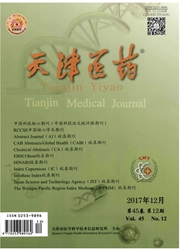

 中文摘要:
中文摘要:
【摘要】目的探讨拟胚体(EBs)培养密度对小鼠胚胎干细胞(ESCs)4~,肌细胞分化的影响。方法小鼠ESCs经过悬滴培养后形成EBs后,以高、低密度(120、60个EBs/60mm组织培养皿)贴壁培养,免疫荧光检测心肌特异性蛋白肌钙蛋白Tffn~的表达。在不同时间点计算不同密度组搏动EBs百分比;RT—PCR检测Nkx2.5、GATA4、8~MHC及ANF基因表达水平;Western-blot检测TnT及p38表达水平。结果通过悬滴培养法形成的EBs能够出现自发性搏动并且有TnT表达。高密度培养组与低密度培养组相比具有更高的搏动EBs百分比,Nkx2.5、GATA4、B—MHC和ANF基因高表达水平,以及TnT蛋白高表达水平(P〈0.05)。高密度培养组的p38活性更高,使用p38特异性阻断剂SB203580能够降低高密度组搏动EBs百分比和TnT蛋白表达水平。结论EBs贴壁培养密度是影响ESCs向心肌细胞分化的一个重要因素,EBs高密度培养相比于低密度培养能够获得更大程度的心肌分化,且该现象可能是由p38信号通路所介导。
 英文摘要:
英文摘要:
Objective To investigate the role of different culture densities of embryoid bodies (EBs) in cardiac dif- ferentiation of mouse embryonic stem cells (ESCs). Methods The mouse ESCs were cultured in hanging drops for 3 days, followed by another 2 days for suspension culture to form EBs. Suspended EBs of different densities (60 or 120 EBs/60 mm tissue culture dish) were transferred onto tissue culture plates. The cardiac specific troponin T (TnT) was detected by immu- nocytochemistry. The percentage of beating EBs was calculated at different time points. The mRNA expression of cardiac spe- cific transcriptional factors Nkx2.5, GATA4 and cardiac specific proteins [3-MHC and ANF were detected by RT-PCR. The protein expressions of TnT and p38 were detected by Western-blot assay. Results Spontaneously beating EBs were posi- tively stained with TnT. There were significantly higher percentage of beating EBs, higher gene expression levels of Nkx2.5, GATA4, [3-MHC and ANF and higher protein expression of TnT in high density culture group than those of low density cul- ture group (P 〈 0.05). Furthermore, there was significantly higher activity of p38 pathway in high density culture group than that of low density cuhure group. And the percentages of heating EBs and TnT protein expression were decreased by p38 pathway inhibitor SB203580. Conclusion The culture density of EBs is important in regulating the cardiac differentiation of ESCs. The high cell-density density culture of EBs enhances the cardiac differentiation of ESCs, which might be mediated by p38 signaling pathway.
 同期刊论文项目
同期刊论文项目
 同项目期刊论文
同项目期刊论文
 期刊信息
期刊信息
